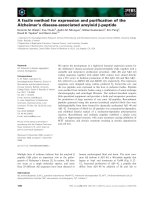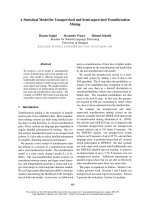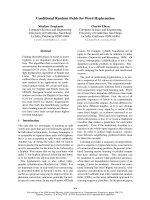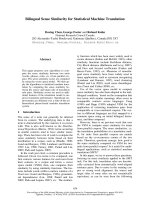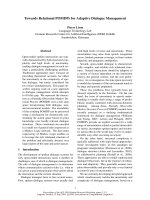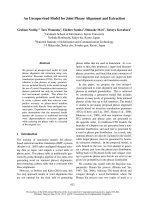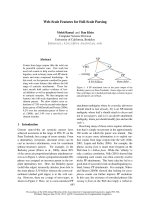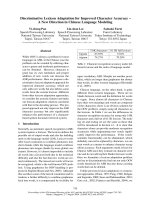Báo cáo khoa học: "Carbon ion radiotherapy for basal cell adenocarcinoma of the head and neck: preliminary report of six cases and review of the literature" docx
Bạn đang xem bản rút gọn của tài liệu. Xem và tải ngay bản đầy đủ của tài liệu tại đây (548.1 KB, 6 trang )
CAS E REP O R T Open Access
Carbon ion radiotherapy for basal cell
adenocarcinoma of the head and neck:
preliminary report of six cases and review of the
literature
Keiichi Jingu
*
, Azusa Hasegawa, Jun-Etsu Mizo, Hiroki Bessho, Takamichi Morikawa, Hiroshi Tsuji, Hirohiko Tsujii,
Tadashi Kamada
Abstract
Background: Basal cell adenocarcinoma accounts for approximately 1.6% of all salivary gland neoplasms. In this
report, we describe our experiences of treatment for BCAC with carbon ion radiotherapy in our instit ution.
Methods: Case records of 6 patients with diagnosis of basal cell adenocarcinoma of the head and neck, who were
treated by carbon ion radiotherapy with 64.0 GyE/16 fractions in our institution, were retrospectively reviewed.
Results: In a mean follow-up period of 32.1 months (14.0-51.3 months), overall survival and local control rates of
100% were achieved. Only one grade 4 (CTCAE v3.0) late complication occurred. There was no other grade 3 or
higher toxicity.
Conclusions: Carbon ion radiotherapy should be considered as an appropriate curative approach for treatment of
basal cell adenocarcinoma in certain cases, particularly in cases of unresectable disease and postoperative gross
residual or recurrent dis ease.
Background
Basal cell adenocarcinoma (BCAC) was first recognized
in 1978 and accounts for approximately 1.6% of all sali-
vary gland neoplasms [1]. BCAC typically arises in
adults older than 60 years of age and has no gender pre-
dominance [2]. The vast majority of BCACs occur in the
parotid gland (about 90%) [3-5], followed b y the sub-
mandibular gland and minor salivary glands [6]. The
2005 WHO classification categorizes BCAC as a low-
grade tumor with a favorable prognosis [7]. The stan-
dard treatment has been wide local excision with or
without postoperat ive radiotherapy. Ho wever, local
recurrence has frequently been reported.
Carbon ion radiation therapy (C-ion RT) was initiated
at the National Institute of Radiological Sciences (NIRS)
in 1994 [8]. For malignant tumors of the head and neck,
a phase II clinical trial with C-ion RT was started in
April 1997. So far, we have treated more than 350
patients with a large histological variety of malignant
tumors of the h ead and neck including mainly mucosal
malignant melanoma an d adenoid cys tic carcinoma. Of
those patients, 6 patients with BCAC of the head and
neck were enrolled. In this report, we describe the 6
patients with BCAC and the efficacy and complications
of C-ion RT.
Methods
Case Presentation
The 6 patients’ characteristics are shown in Table 1.
Mean age was 58 years (range: 37-81 years). None of
the patients had metastasis in distant organs. The pri-
mary sites were parotid gland in 4 patients, base of the
tongue in 1 patient and ethmoid sinus in 1 patient. The
stages for all patients were defined according to Unio
Intern ationalis Contra Ca ncrum (UICC) 2002. Histology
of all patients was rec onfirmed by a pathologist in our
institution before C-ion RT.
* Correspondence:
Research Center for Charged Particle Therapy, National Institute of
Radiological Sciences (NIRS), Chiba, Japan
Jingu et al. Radiation Oncology 2010, 5:89
/>© 2010 Jingu et al; licensee BioMed Central Ltd. This is an Open Access article distributed und er th e terms of the Creat ive Commons
Attribution License (http://crea tivecommons.org/licenses/by/2.0), which permits unrestricted use, distribution, and reproduction in
any medium, provided the original work is properly cited.
Clinical Histories
Patient 1
A 43-year-old Japanese male developed a sore throat
over a period of 3 months. A tumor at the base of the
tongue was detected by endoscopy. The pathological
diagnosis was BCAC by biopsy. CT revealed that the
clinical stage was T4aN0M0 (stage IVA). The diameter
of the primary tumor was 29 mm. At first, one cycle of
chemotherapy, including cisplatin, 5-FU and docetaxel,
was performed in the previous hospital; however, the
tumor did not show shrinkage. He therefore came to
our institution for C-ion RT.
Patient 2
A 70-year-old Japanese male had nasal bleeding for one
week. A tumor in the right ethmoid sinus was detected
by endoscopy and CT in the p revious hospital. Biopsy
was performed in the previous hospita l, and the diagno-
sis was BCAC (MIB-1 index, 50-80%) in the right eth-
moid sinus with intracranial invasion. The diameter of
the primary tumo r was 50 mm and there was no lym-
phadenopathy (cT4aN0M0, stageIVA).Therewasno
indication for surgery. He came to our institution for
C-ion RT. The patient had bilateral retinal detachm ents
as a past history.
Patient 3
A 62-year-old Japanese female had undergone right total
parotidectomy in the previous hospital (pT3N0M0, stage
III, R0). The pathological diagnosis was BCAC. There-
after, follow-up was perf ormed every 3 months. Eight
years after parotidectomy, a tumor of 54 mm in dia-
meter was detected under the right temporal skin by
MRI, and BCAC recurrence was confirmed by biopsy.
No lymphade nopathy was detected. There was no indi-
cation for surgery. She came to our institution for C-ion
RT.
Patient 4
A 37-year-old Japanese female developed fullness in the
right ear and right buccal swelling over a period of 3
months. She underwent fine needle biopsy and was diag-
nosed as cytologic class III in the previous hospital. Total
parotidectomy +/- postoperative radiotherapy was
planned. CT revealed that the clinical stage was T3N1M0
(stage III). The diameter of the primary tumor was 54 mm
and the diameter of the right upper cervical lymph node
was 18 mm. However, she declined surgery and requested
C-ion RT. We required the previous hospital to perform
biopsy for confirming the histology. Thereafter, her tumor
was diagnosed as BCAC (MIB-1 index, 10%).
Patient 5
An 81-year-old Japanese male developed left buccal
swelling over a period of one and half years. A benign
tumor was suspected by CT, but the histological diagno-
sis was BCAC by biopsy. The clinical stage was
T4aN0M0 (stage IVA). The diameter of the primary
tumor was 52 mm and there was no lymphadenopathy.
If curative surgery was performed, facial nerve palsy
coul d not be avoided . For this reason, he declined cura-
tive surgery and selected C-ion RT.
Patient 6
A 55-year-old Japanese male had right buccal swelling.
A benign tumor was suspected and observation was per-
formed. Four years later, a gastric malignant tumor was
found by medical examination. Right partial parotidect-
omy was performed simultaneously with total gastric
resection. The histological diagnosis of the parotid
tumor was BCAC with suspected residual macroscopic
tumor (pT4aN0M0, stage IVA, R2). For gastric cancer,
chemotherapy including TS-1 was performed for 6
months after surgery. However, a gross tumor of 19 mm
in diameter in his right parotid gland remained. He
selected C-ion RT.
Treatment
All of the patients were not indicated for curative sur-
gery or decli ned surgery, and C- ion RT w as performed
as follows.
Table 1 Patients’ Characteristics
Patient Age Gender Primary
Site
Stage (UICC§ 2002) Tumor Response
(RECIST*)
Grade 3 or more Toxicities
(CTCAE† v3.0)
Observation Period
(months)
1 43 M base of
tongue
cT4aN0M0 PR none 25.9
2 70 M ethmoid
sinus
cT4aN0M0 PR Grade 4 retinopathy 20.9
3 62 F parotid
grand
postoperative recurrence
(pT3N0M0, R0)
CR none 14.0
4 37 F parotid
grand
cT3N1M0 PR none 49.6
5 81 M parotid
grand
cT4aN0M0 SD none 51.3
6 55 M parotid
grand
postoperative residual
(pT4aN0M0, R2)
CR none 31.3
Abbreviation, §Unio Internationalis Contra Cancrum; *Response Evaluation Criteria in Solid Tumors; †Common Terminology Criteria for Adverse Events.
Jingu et al. Radiation Oncology 2010, 5:89
/>Page 2 of 6
Carbon Ion Radiotherapy
Doses of carbon ions were expressed in photon equiva-
lent doses (GyE), which were defined as the physical
doses multiplied by the RBE of the carbon ions. The
biological flatness of the SOBP was normalized by the
survival fraction of human salivary gland tumor cells at
the distal regi on of the SOBP, where the RBE of carbon
ions was assumed to be 3.0 [9].
The patients were positioned in customized cradles
(Moldcare; Alcare, Tokyo, Japan) and immobilized with a
low-temperature thermoplastic shell (Shellfitter; Kuraray,
Osaka, Japan). A set of 2.5-mm-thick computed tomogra-
phy (CT) images was taken for treatment planning with
the immobilization devices. CT imaging alone is inade-
quate for detection of extension of the tumor. Therefore,
MRI was routinely used for identification of the tumor,
after fusing it with the planning CT. Determination of
gross target volume (GTV) was b ased on contrast-
enhanced MRI. The clinical target volume (CTV) had
minimummarginsof5.0mmaddedaroundtheGTV.
The planning target volu me (PTV) included margins of
3.0- 5.0 mm around the CTV, and this could be modified
manually. The PTV and OAR (e.g., eyeball wall, optic
nerve, optic chiasma and brain stem) were outlined on the
planning CT images to permit dose-volume histogram
(DVH) analysis. Three-dimensional treatment planning
was performed using HIPLAN software (National Institute
of Radiological Sciences, Chiba, Japan) [10]. The PTV was
ensured with at least 95% of the prescription dose.
Irradiation was carried out once per day for 4 days per
week (Tuesday-Friday) with carbon ion beams. The pre-
scribed dose to the center of the CTV was 64.0 GyE/16
fractions over 4 weeks at 4.0 GyE/fraction per day in all
of the 6 patients. Thereafter, no other treatments were
performed for any patients.
Follow-up
The patients were followed up by CT or MRI every 1 or 2
months for the first 6 months after C-ion RT and there-
after every 3 to 6 months. The ove rall survival and local
control rates were calculated from the first day of C-ion
RT. Toxicities were classified according to Common Ter-
minology Criteria for Adverse Events (CTCAE) v3.0.
Results
All of the patients underwent C-ion RT without an
interval, and all of the patients were alive at the last
observation date. No patient was lost to follow-up. The
mean observation period was 32.1 months (range: 14.0-
51.3 months). There were no local or regional recur-
rences or metastasis in distant organs. Tumor response
rate according to Response Evaluation Criteria in Solid
Tumors (RECIST) was 66.7%, including 1 CR, 3 PR and
2SD,at6monthsaftercompletionofC-ionRT.MR
images of 2 representative patients before and after
C-ion RT and dose-distributio ns of C-ion RT are shown
in Figures 1 and 2, respectively.
Onepatientwhohadatumorintheleftethmoid
sinus had grade 4 left retinopathy (light perception)
about 12 months after completion of C-ion RT. Three
of the 4 patients who had a tumor in the parotid gland
did not show facial nerve palsy; however one patient
showed slight facial nerve palsy 6 months after C-ion
RT. There was no other grade 3 or higher toxicity in
the 6 patients.
Discussion
Since BCAC seldom metastasizes to cer vical lymph
nodes, routine neck dissection is not recommended.
Themortalityrateforthistumor is also low, although
reported local recurrence rates are high. In a review,
local recurrence was observed in 37% (17/46) of patients
with follow-up between 6 months and 2 years [2]. In
another review, local recurrence was observed in 44.4%
(8/18) of patients with follow-up between 2 years and
14.3 years [11]. From the above experiences, it would
appear that the first treatment of ch oice for BCAC is
wide local excision with frozen-section control of the
resection margins. However, sufficient resection margins
often cannot to be obtained due to the need for preser-
vation of critical organs (e.g., the facial nerve in parotid
tumors). Therefore, postoperative radiotherap y has been
proposed for lesions with a high risk of vascular and
neural invasion and for lesions that are diffusely infiltra-
tive, especially in patients with close resection margins
[12]. Even with wide local excision and postoperative
radiotherapy, local recurren ce has been reported in
about 30-50% of patients (Table 2) [2,11,13]. To our
knowledge, this is the first report of BC AC treated with
radiation alone. Although observation period of the pre-
sent cases was not enough, C-ion RT achieved good
local control among past reports. A possible explanation
for the success we have seen with C-ion RT of BCAC
concerns the differences in biological interactions of car-
bon ion radiation and photon radiation in tissue. Com-
pared to photon radiation, high linear energy transfer
(LET) radiation is characterized by less variation of sen-
sitivity through the cell c ycle [14], by less or no r epair
of sublethal or potentially lethal cell damage, which is a
problem in controlling repair-proficient photon-resistant
tumors, and by a reduced oxygen enhancement fac tor
(OER) in the case of hypoxic and poorly-reoxygenating
tumors. An indolent tumor such as BCAC with conse-
quent ability to repair potentially lethal damage from
low LET radiation might have an increased responsive-
ness to C-ion RT. High LET radiation, including C-ion
RT, could be a favorable curative treatment for BCAC.
More long-term observation is required.
Jingu et al. Radiation Oncology 2010, 5:89
/>Page 3 of 6
With regard to to xicities, severe unilateral retinopathy
occurred in one patient (patient 2) even with exce llent
dose-distribution of C-ion RT since the critic al organ
was next to the tumor. We have already revealed the
dose constraints of optic nerves for C-ion RT [15].
Severe retinopathy was considered to be unavoidable in
that patient. Grade 3 or more toxicity was observed in
only that patient. Brown et al. reported that severe facial
nerve palsy occurred in 26% of 66 patients who under-
went surgery even with facial nerve graft for a parotid
neoplasm and postoperative radiotherapy, [16]. On the
other hand, Buchholz et al. reported that fa cial nerve
palsy occurred in one of 6 patients with recurrent pleo-
morphic adenoma treated by fast neutron radiotherapy,
which is also high LET radiation [17]. Duthoy et al.
reported that decrease of vision occurred in 5 of
39 patients with sinonasal carcinoma tr eated with
postoperative intensity-modulated radiation therapy
[18]. Compared with those treatment methods, C-ion
RT is considered to be acceptable. However, the average
time of progression to eventual radiation- induced visual
loss was 25.6 months (range, 10-41 mont hs) after C-ion
RT in o ur previous investigation [15]. Although facial
nerves are conside red to b e stronger t han optic nerves
for C-ion RT since peripheral nerves are known to have
more radio-resistance than central nerves [19], more
facial nerve palsy in patients with a tumor in the parotid
gland may occur in the long term. The acceptable dose
of C-ion RT for facial nerves is currently under
investigation.
Conclusions
We reported preliminary but excellent effica cy of C-ion
RT for BCAC, which is very rare head and neck
Figure 1 Patient 2, a 70-year-old Japanese male with BCAC in the ethmoid sinus. (a) Axial contrast-enhanced T1-weighted MR image
before C-ion RT, (b) Coronal contrast-enhanced T1-weighted MR image before C-ion RT, (c) Histological findings of HE staining at low-
magnification, (d) Histological findings of HE staining at high-magnification, (e) Dose-distribution of C-ion RT in axial and coronal CT images,
(f) Axial contrast-enhanced T1-weighted MR image 1 year after C-ion RT, (g) Coronal contrast-enhanced T1-weighted MR image 1 year after
C-ion RT.
Jingu et al. Radiation Oncology 2010, 5:89
/>Page 4 of 6
malignant tumor, in 6 patients. Our results showing
acceptable toxicities and appreciable efficacy suggest
that C-ion RT could be one of the curative primary
treatments of BCAC.
Consent
Written consent for publication was obtained from all of
the patients before C-ion RT in our institution.
Authors’ contributions
KJ and AH conceived the idea, did the literature search and prepared the
manuscript. KJ, AH, JM, HB, TM and HT performed treatment and follow-up
and acquisition of data. TK and HT provided critical review of the manuscript
and research guidance. All authors read and approved the final manuscript.
Competing interests
The authors declare that they have no competing interests.
Received: 15 July 2010 Accepted: 4 October 2010
Published: 4 October 2010
References
1. Klima M, Wolfe K, Johnson PE: Basal cell tumors of the parotid gland. Arch
Otolaryngol 1978, 104:111-116.
Figure 2 Patient 5, an 81-year-old Japanese male with BCAC in the left parotid gland. (a) Axial contrast-enhanced T1-w eighted MR image
before C-ion RT, (b) Coronal contrast-enhanced T1-weighted MR image before C-ion RT, (c) Histological findings of HE staining at low-
magnification, (d) Histological findings of HE staining at high-magnification, (e) Dose-distribution of C-ion RT in axial and coronal CT images, (f)
Axial contrast-enhanced T1-weighted MR image 3 years after C-ion RT, (g) Coronal contrast-enhanced T1-weighted MR image 3 years after C-ion RT.
Table 2 Literature Review of Treatment Results for Basal
Cell Adenocarcinoma
Author n Observation
Period (mean)
Treatment Local
Recurrence
Muller et al.
[2]
7 5-192 months
(54 months)
Surgery
+/- X-ray
2/7
Parashar
et al. [11]
18 2-14.3 years
(5.1 years)
Surgery
+/- X-ray
8/18
Nagao et al.
[13]
10 1-18 years
(6.5 years)
Surgery
+/- X-ray
5/10
current
series
6 14.0-51.3 months
(32.1 months)
Carbon ion
radiotherapy
0/6
Jingu et al. Radiation Oncology 2010, 5:89
/>Page 5 of 6
2. Muller S, Barnes L: Basal Cell Adenocarcinoma of the Salivary Glands.
Report of Seven Cases and Review of the Literature. Cancer 1996,
78:2471-2477.
3. Ellis GL, Wiscovitch JG: Basal cell adenocarcinoma of the major salivary
glands. Oral Surg Oral Med Oral Pathol 1990, 69:461-469.
4. González-García R, Nam-Cha SH, Muñoz-Guerra MF, Gamallo-Amat C: Basal
cell adenoma of the parotid gland: case report and review of the
literature. Med Oral Patol Oral Cir Bucal 2006, 11:E206-209.
5. Franzen A, Koegel K, Knieriem JH, Pfaltz M: Basal cell adenocarcinoma of
the parotid gland: a rare tumor entity: Case report and review of the
literature. HNO 1998, 46:821-825.
6. Ellis GL, Auclair PL: Tumors of the salivary glands. Atlas of tumor pathology,
3rd series, fascicle 17 Washington, D.C.: Armed Forces Institute of Pathology
1996, 257-267.
7. Barnes L, Eveson JW, Reichart P, Sidransky D: Pathology and Genetics of
Tumours of the Head and Neck. World Health Organization Classification of
Tumours Lyon, France: IARC Press 2005, 9.
8. Hirao Y, Ogawa H, Yamada S, Sato Y, Itano A, Kanazawa M, Noda K,
Kawachi K, Endo M, Kanai T, Kohno T, Sudou M, Minohara S, Kitagawa A,
Soga F, Takada E, Watanabe S, Endo K, Kumada M, Matsumoto S: Heavy ion
synchrotron for medical use -HIMAC project at NIRS, Japan Nuclear
Physics A 1992, 538:541-550.
9. Kanai T, Endo M, Minohara S, Miyahara N, Koyama-ito H, Tomura H,
Matsufuji N, Futami Y, Fukumura A, Hiraoka T, Furusawa Y, Ando K,
Suzuki M, Soga F, Kawachi K: Biophysical characteristics of HIMAC clinical
irradiation system for heavy-ion radiation therapy. Int J Radiat Oncol Biol
Phys 1999, 44:201-210.
10. Endo M, Koyama-Ito H, Minohara S, Miyahara N, Tomura H, Kanai T,
Kawachi K, Tsujii H, Morita K: HIPLAN-a heavy ion treatment planning
system at HIMAC. J Jpn Soc Ther Radiol Oncol 1996, 8:231-238.
11. Parashar P, Baron E, Papadimitriou JC, Ord RA, Nikitakis NG: Basal cell
adenocarcinoma of the oral minor salivary glands: review of the
literature and presentation of two cases. Oral Surg Oral Med Oral Pathol
Oral Radiol Endod 2007, 103:77-84.
12. Jayakrishnan A, Elmalah I, Hussain K, Odell EW: Basal cell adenocarcinoma
in minor salivary glands. Histopathology 2003, 42:610-614.
13. Nagao T, Sugano I, Ishida Y, Hasegawa M, Matsuzaki O, Konno A, Kondo Y,
Nagao K: Basal cell adenocarcinoma of the salivary glands: comparison
with basal cell adenoma through assessment of cell proliferation,
apoptosis, and expression of p53 and bcl-2. Cancer 1998, 82:439-447.
14. Hall EJ: New radiation modalities. In Radiobiology for the radiologist Edited
by: Hall EJ , 3 1988, 261-291.
15. Hasegawa A, Mizoe JE, Mizota A Tsujii H: Outcomes of visual acuity in
carbon ion radiotherapy: Analysis of dose-volume histograms and
prognostic factors.
Int J Radiat Oncol Biol Phys 2006, 64:396-401.
16. Brown PD, Eshleman JS, Foote RL, Strome SE: An analysis of facial nerve
function in irradiated and unirradiated facial nerve grafts. Int J Radiat
Oncol Biol Phys 2000, 48:737-743.
17. Buchholz TA, Laramore GE, Griffin TW: Fast neutron radiation for recurrent
pleomorphic adenomas of the parotid gland. Am J Clin Oncol 1992,
15:441-445.
18. Duthoy W, Boterberg T, Claus F, Ost P, Vakaet L, Bral S, Duprez F, Van
Landuyt M, Vermeersch H, De Neve W: Postoperative intensity-modulated
radiotherapy in sinonasal carcinoma: clinical results in 39 patients.
Cancer 2005, 104:71-82.
19. Emami B, Lyman J, Brown A, Coia L, Goitein M, Munzenrider JE, Shank B,
Solin LJ, Wesson M: Tolerance of normal tissue to therapeutic irradiation.
Int J Radiat Oncol Biol Phys 1991, 21:109-122.
doi:10.1186/1748-717X-5-89
Cite this article as: Jingu et al.: Carbon ion radiotherapy for basal cell
adenocarcinoma of the head and neck: preliminary report of six cases
and review of the literature. Radiation Oncology 2010 5:89.
Submit your next manuscript to BioMed Central
and take full advantage of:
• Convenient online submission
• Thorough peer review
• No space constraints or color figure charges
• Immediate publication on acceptance
• Inclusion in PubMed, CAS, Scopus and Google Scholar
• Research which is freely available for redistribution
Submit your manuscript at
www.biomedcentral.com/submit
Jingu et al. Radiation Oncology 2010, 5:89
/>Page 6 of 6
